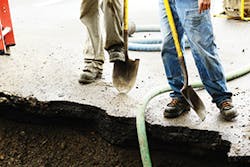Stopping a Sinkhole: A Case Study (Part 1)
This article first appeared in the May 2016 issue of Water Efficiency. Read part 2 here.
Flooding, sinkholes, danger, suspense, a race against time, and Mother Nature—this story is not the latest adventure film served up by Hollywood, but it could be! In 2013, the real-life saga of the stormwater pipe collapse of Birmingham’s Highway 280, one of Alabama’s busiest roadways, has every element to rival an action blockbuster.
Location Is Everything (Especially in Stormwater Management)
The collapse occurred in an upscale shopping area called The Summit, which is appropriately named for its high elevation and spectacular view of the Appalachian mountain ridges. This 1-million-square-foot retail environment opened in 1997 and is considered Birmingham’s premier shopping and dining destination. The Summit is a luxury environment of manicured grounds and high-end stores, but it also has more than 100 acres of impermeable surface—parking lots and roofs. Runoff from the site flows to a detention pond at the bottom slope of the shopping area.
Charles Malone, assistant area administrator of maintenance and a 40-year veteran of the Alabama Department of Transportation, describes the situation: “So here we have this nice, manicured grass area, beautiful flowers, trees, and landscaping, and we get a call one morning that there is suddenly a 40-foot sinkhole.”
In retrospect, Malone says he knows that the sinkhole didn’t happen overnight, but was the outcome of a series of events that were most likely progressing to disaster “for at least a few years.”
But at the time no one knew this, he explains.
“The detention pond has a concrete overflow pipe, and this connects with a junction box down in the pond. When the water level increases, it flows into the pipe and connects down into a corrugated pipe system that is 65 feet underground and passes under Highway 280,” says Malone.
This six-lane, divided highway that interchanges with Interstate 459 near The Summit makes it one of the busiest arteries in the state. But because of the elevation of the shopping center, the stormwater system at The Summit collects runoff and then drops 65 vertical feet underground, connecting to the transverse pipe under the road that exits almost 500 feet away into a receiving lake that is situated on an AT&T corporate campus.
This design makes it a closed system on both ends, which Malone says does not allow for routine inspections because there is no way to get in at either point. And inaccessibility keeps problems concealed and undetected.
Malone speculates that the pipe collapse had already occurred much earlier than the development of the sinkhole. He surmises that when the detention pond experienced previous flooding and required repair a few months earlier, it was probably an early warning that a much more severe problem was developing underground.
“While it was in this stage of being partially collapsed, it was pulling materials down from the top, and we think this was creating a kind of cavern effect up on the surface. You didn’t notice it to start, but eventually with enough materially falling away underneath, it finally collapsed from the top, then sunk down 10 to 15 feet and grew to 40 feet in diameter, and then this started filling up with stormwater because it couldn’t go anywhere else.”
But he says the deterioration created significant impact.
“After 30 or 40 years, that pipe was rusted and corroded, and the weight of the overburden caused it to collapse. It wasn’t just dirt, but rocks and boulders from the fill material,” which had created an urgent situation. The corrugated metal pipe was likely made of galvanized steel, as it was the standard coating of that time. Since then, several premium coatings have been developed that provide 75 years or more of service life.
But while this flooding sinkhole got everyone’s attention, there was no clue to the true damage. Malone immediately called upon Video Industrial Services Inc., which had assisted the DOT in another high-profile shopping area, to enlist the company’s help and assess the full scope of the damage.
Editor’s note: In part one of this three part series on Stopping a Sinkhole, we looked at how a sinkhole is formed and the first steps stormwater professionals took to assess the damage. Read part 2 here.


